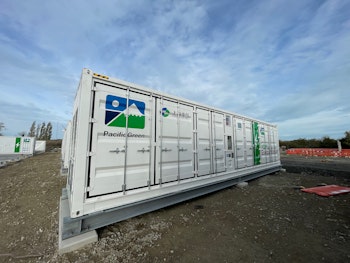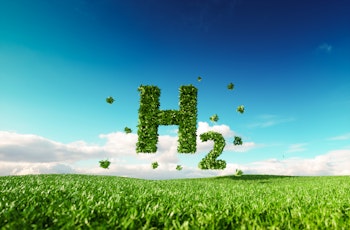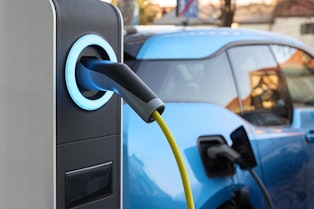The last year has seen major developments in cleantech, with initiatives such as Europe’s REPowerEU and America’s Inflation Reduction Act forcing the pace of progress.
And 2023 looks to be every bit as exciting as nations and industries ramp up their commitments to emissions reduction. Although it is impossible to tell what the next 12 months will hold, here are 10 trends that we feel sure will remain relevant throughout the year.

Storage will continue to grow
With wind and solar power now established as the most cost effective and easily deployed new forms of generation, energy storage is needed in ever-greater quantities.
Not only is this good for the grid but also for investors, since battery systems are a sound business proposition in markets ranging from Australia to the UK.
Although the variety of energy storage technologies is expanding, tried-and-tested lithium-ion battery systems look set to dominate the market for the foreseeable future.
Carbon capture and storage will garner attention
Carbon capture and storage, or CCS, is seen as having a role to play in the energy transition by allowing fossil fuel generation to continue without contributing to climate change.
CCS has been around for decades, but its track record is patchy with detractors claiming the technology has had little real-world impact on emissions and serves as an excuse for oil companies to keep drilling.
However, CCS incentives in the US mean the technology could be put to the test in 2023, potentially contributing to the decarbonisation of the power sector, heavy industry and perhaps even shipping.
Industrial decarbonisation will pick up speed
For some years now, hard-to-abate industries from steelmaking to marine transport have been working out how best to reduce their emissions.
Many of these sectors now have technologies such as green hydrogen at their disposal, along with a growing mandate from customers and investors to move ahead with decarbonisation.
Although the pathway for sectors such as shipping is still unclear, 2023 is likely to be a year of growing cleantech innovation and momentum for these industries.
The practicalities of green hydrogen will come to the fore
Green hydrogen has been mooted as a decarbonisation tool for everything from aviation to domestic heating. In practice, the gas is probably not suitable for all these applications—and might not be as easy to make and sell as people think.
As the first large-scale green hydrogen projects get off the ground in 2023, experienced project developers will be required to ensure the product lives up to its promise—and there will be plenty of learning about what works and what does not.

Plans for clean ammonia will grow
As the practical challenges of green hydrogen become apparent, it is likely there will be a growing focus on low-carbon ammonia as a fuel storage and transport medium.
Ammonia is already a major industrial compound and producing it at scale, for example using concentrated solar power, represents an important commercial opportunity.
Further down the line, ammonia is one of the top contenders to power seaborne shipping, although in the short term the industry may need to focus on reducing emissions through the deployment of technology such as scrubbers.
Concentrated solar power will expand behind the scenes
Compared to photovoltaics, concentrated solar power or CSP is something of a Cinderella technology, with attractive attributes that are frequently overlooked in the wider cleantech sphere. That picture is starting to change in select markets, however.
Spain held an auction for CSP in 2022, albeit with a price ceiling that was not viable in the current inflationary climate, and there are signs the technology could find a home in Australia.
But the big growth market is in China, where more than 4 GW of capacity is planned to come online between 2023 and 2024, according to CSP Focus, an industry information provider.
Resilience will rise on the grid operators’ agenda
Despite our efforts to curb climate change the fact is that emissions are still on the up and the amount of carbon locked in the atmosphere is already having an impact on weather patterns.
For grid operators, this means more wildfires, more floods and more situations where the grid is stressed, leading to blackouts and overloading.
It remains to be seen how grid companies will respond to this growing threat, although one likely outcome is the creation of mini and microgrids that can use battery power to operate independently of wider electricity networks if required.

Electric vehicles will go mainstream
Electric vehicle sales have already overtaken new internal combustion engine car registrations in some parts of the world and this trend is only set to continue in 2023 as governments seek to decarbonise the transport sector and charging infrastructure becomes more widespread.
Growing levels of vehicle electrification will have a knock-on effect on grid architectures, requiring the deployment of massive amounts of energy storage to maintain electricity network stability as the auto industry becomes dependent on electrons instead of oil for power.
Solar photovoltaic will continue to shine
Already the world’s cheapest and easiest form of generation across much of the world, solar photovoltaic (PV) technology is poised to go from strength to strength in 2023.
The technology is expected to hit a terawatt of generation capacity before the year is out, expanding rapidly despite recent cost increases resulting from polysilicon shortages.
As part of this growth, expect to see PV being used just about anywhere generation capacity is needed, from neighbourhood rooftops to mining and processing centres in the desert.
Investors will flock to cleantech
Volatility has been a bugbear for financial markets over the last year, but cleantech has remained a relatively safe bet amongst the turmoil.
Renewable energy and battery storage projects provide regular, long-term revenue streams that can be hedged against pricing fluctuations and regulatory uncertainty through corporate power-purchase agreements and similar instruments.
A further bonus for investors is demand for clean energy is only set to grow—not just in 2023, but for the coming decades. To find out how we can help your cleantech ambitions become a reality in 2023, contact us now.
Publish date: 21 December, 2022